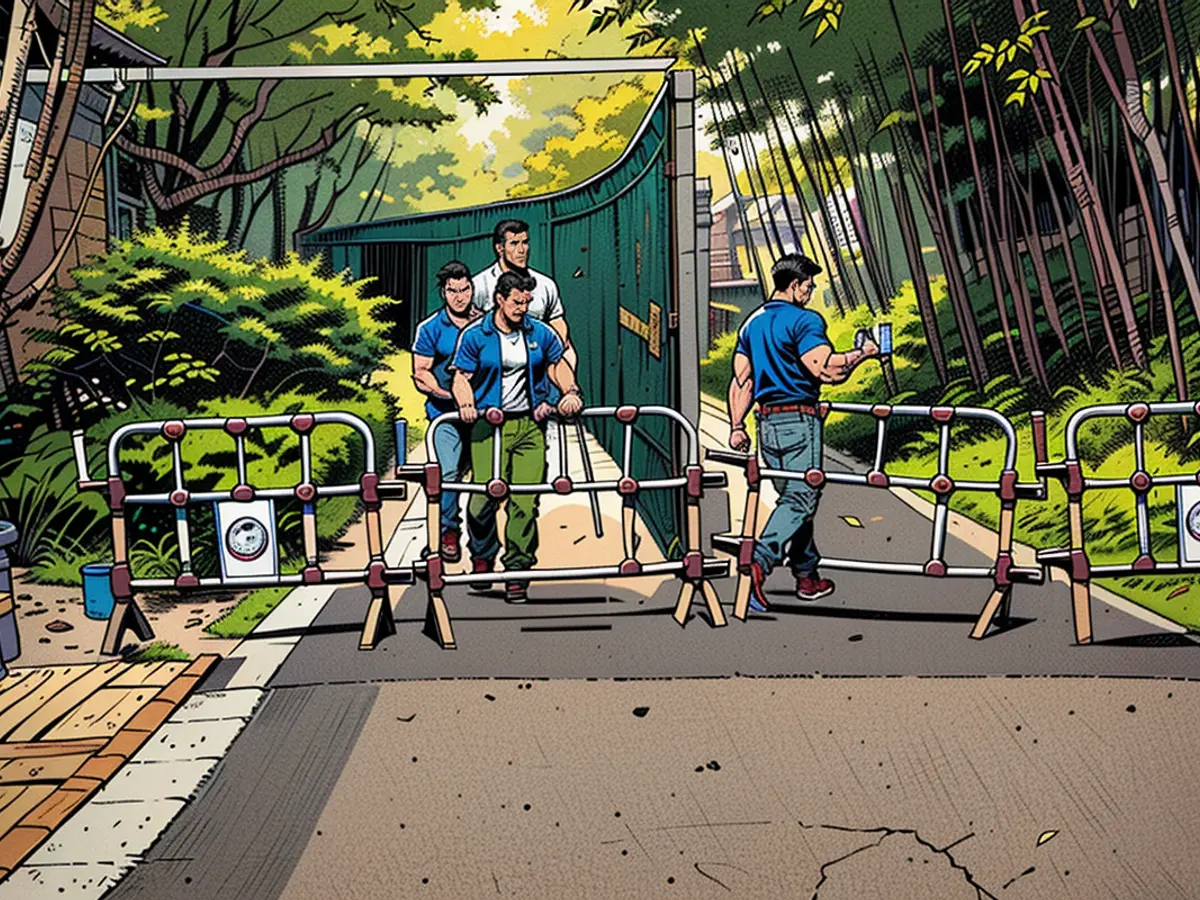Adorable and huggable, these new diplomats from China's panda population are making their way to America, specifically Washington.
Little Li and Lazy Bear, both three years old, departed from the giant panda research center in Dujiangyan, a city near the bears' native habitat in southwest China's mountains, on Monday evening local time. They're set to board a chartered FedEx Boeing 777 cargo plane named "Panda Express" and take off for Washington in a few hours.
This will be the first pair of pandas China has sent to Washington in 24 years. The last pair returned to China with their cub last November, causing an outpouring of emotional goodbyes at the Smithsonian's National Zoo.
Over the past 11 months, the zoo's panda exhibit, which used to attract millions of visitors, has been empty. After undergoing a million-dollar makeover, it's now eagerly counting down the hours to welcome its new residents.
China's decision to renew its panda diplomacy with the US is a positive development in the strained relations between the two global powerhouses, which have been marked by trade disputes, tech tensions, geopolitical conflicts, and more.
A farewell ceremony was held earlier on Monday at a hotel near the base, attended by a delegation from the Washington zoo who had come to help with the transition in Sichuan Province.
Addressing the gathering, the zoo's director, Brandie Smith, praised half a century of cooperation between the Smithsonian and its Chinese partners in panda conservation, since the first pair arrived from China in 1972.
"These beloved black and white bears are icons in Washington DC, and are cherished worldwide," Smith said. "Our team and legions of fans eagerly await the arrival of Li Little and Lazy Bear at the Smithsonian’s National Zoo."
The two pandas will be leased to the Smithsonian's National Zoo for 10 years, with an annual fee of $1 million to support conservation efforts in China.
Little Li was born in Sichuan, but he has strong ties to Washington. His mother, Bao Bao, was a star at the National Zoo in 2013 before returning to China four years later. His grandparents, Meixiang and Tian Tian, lived at the zoo for 23 years until their lease expired last year.
"He reminds me a lot of his grandfather, Tian Tian," said Mariel Lally, a panda keeper from the National Zoo who is accompanying Little Li and Lazy Bear on their flight to Washington.
"Little Li looks incredibly like him, so it's like having Tian Tian Junior," she told CNN in Dujiangyan the day before the bears' departure.
"A very comfortable journey"
Extensive preparations have been made for the two pandas' journey across the Pacific Ocean.
Lally has spent the past 10 days at the Dujiangyan base getting familiar with the two pandas and working with their Chinese caretakers for the transfer. Two more colleagues – a vet and another keeper – arrived from Washington last week to join the training.

Little Li and Lazy Bear were removed from public display and isolated in quarantine on September 13 – a day after Lazy Bear turned three years old. (Little Li had his birthday five weeks earlier.) They were housed in separate enclosures in a fenced-off quarantine zone lined with bamboo trees, tucked away in a quiet staff-only area away from the throngs of tourists.
Ren Zhijun, a Chinese caretaker who has been looking after the two bears in quarantine, noted their starkly different personalities.
Little Li is lively and has a big appetite – living up to his name, which means "precious vigor." Lazy Bear, which means "green treasure," is "lazy and loves to sleep," Ren said. "When she wants to exercise, she'll climb a tree."
Ren also noted a significant difference in their appetite: Little Li, who loves bamboo shoots, can eat twice as much bamboo as Lazy Bear, who favors carrots and apples.
Having cared for the bears for weeks, it would be difficult to say goodbye, Ren told CNN on Sunday. "The pandas are like my own children," he said.
Little Li and Lazy Bear spent their last few days in Dujiangyan getting ready for their first long-haul flight. Every morning, the pair would willingly enter their shipping crates as soon as the door opened, with just a little help from food.
"They go in there, they get their favorite treats, and it's actually challenging to get them out of it," Lally said. "They're really comfortable in there, and the crates are enormous. They could lay down in either direction, stand up, do a cartwheel – you name it, there's plenty of space."
The crates are designed to allow keepers to provide bamboo, bamboo shoots, fruits, and fresh water to the bears during the flight.
"They'll have a very comfortable journey even though it's gonna be a long journey," Lally said.
"A new chapter"
The Smithsonian's National Zoo was the first in the US to display these rare, cuddly creatures as part of China's "panda diplomacy" – a strategic tool to win allies, build goodwill, and showcase soft power.
It all began with US President Richard Nixon's diplomatic trip to Communist China during the Cold War. During that historic visit in 1972, first lady Pat Nixon was reportedly "charmed" by the pandas at the Beijing Zoo.
Days later, when seated next to Chinese Premier Zhou Enlai at a banquet in Beijing, Pat Nixon noticed a box of cigarettes on the table adorned with pandas. "Aren't they cute? I love them," she told his host. "I'll give you some," he replied.

A few weeks past, a pair of pandas named Ling Ling and Hsing Hsing touched down at the National Zoo in Washington. "I predict pandemonium is about to erupt here at the zoo," Pat Nixon cracked joked during the welcoming ceremony.
She wasn't far off. When Ling Ling and Hsing Hsing made their debut in public viewing, they attracted an estimated 20,000 visitors. Giant pandas have since taken center stage at the zoo, pulling in millions.
The zoo's 24-hour Panda Cam has accumulated over 100 million page views since its launch back in 2000. Unfortunately, it went offline last November when Mei Xiang, Tiantian, and their cub Xiao Qi Ji moved back to China.
For many Washington D.C. residents, Mei Xiang, Tiantian, and Xiao Qi Ji's departure marked the end of an era: the National Zoo's giant panda exhibit hadn't been void since 1993.
Their absence also fueled some unease. San Diego and Memphis had already returned their pandas to China, and Atlanta's few remaining pandas were scheduled to say their goodbyes.
The exodus was somewhat predictable, given the zoos' panda leases were set to expire. However, it came at a tense time in U.S.-China relations. Some speculated Beijing was halting its "panda diplomacy" with the U.S. and instead offering new loans to Europe and the Middle East.
But, in a bid to mend fences, Chinese leader Xi Jinping hinted in San Francisco last November that China would send new pandas to the U.S., likening them to "emissaries of friendship between the Chinese and American people."
A new round of "panda diplomacy" ensued. In June, a pair of pandas arrived at the San Diego Zoo, shortly after the National Zoo announced it would welcome two new bears by year's end.
Smith, the National Zoo's director, hailed the impending arrival of Bao Li and Qing Bao as "a historic moment" marking the beginning of the zoo's giant panda conservation program's next phase.
"Giant pandas highlight how significant conservation achievements can stem from powerful collaborations and public support," she said.
However, not every Chinese citizen was thrilled about these international loans. A sizable, vocal group of internet influencers have vehemently protested sending China's national treasures overseas.
Some questioned the welfare of pandas in foreign zoos, baselessly claiming they've suffered mistreatment. Such claims, usually stirred by nationalistic, anti-American sentiment, gained traction in Chinese social media post-the health scandal involving Ya Ya, a panda occupying the Memphis Zoo.
When Bao Li and Qing Bao went into quarantine in September, the China Conservation and Research Center for Giant Panda issued a statement denying rumors of mistreatment in the Washington Zoo.

"International giant panda cooperation carries great significance," the center asserted, stressing they had debunked such rumors before. "We understand the concern for Tian Tian and Yang Yang, but please refrain from heeding internet gossip," it added.
The renewed panda diplomacy between China and the US is seen as a positive development in the strained relations between the two global powerhouses.
Little Li, who was born in Sichuan, has strong ties to Washington as his mother, Bao Bao, was a popular figure at the National Zoo before returning to China four years ago.







